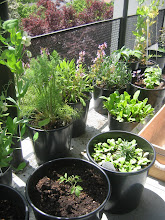Wednesday, December 19, 2012
Steamed Chicken & Chestnuts
Pete & I made this once before, by which I mean, Pete made it while I had a beer or something. It was always one of my favorite dishes that Dad used to cook for his insane chinese Thanksgiving feasts, but of course he used turkey for that. I wish there was a way to make this a little more photogenic, but it really isn't a visually exciting food. Oh well. Makes up for it by being delicious. I think I got in trouble for eating all the chestnuts out of the dish when I was little. This is a small recipe, unlike the banquet-sized version Dad used to make.
1 cup sticky rice, like sushi rice or thai sweet rice. Arborio rice for risotto would probably work too.
1 lb boneless chicken
3 T white wine if you have it, or a small splash of rice or cider vinegar
1 tsp minced fresh ginger
1 T sesame oil
4 T light soy sauce
a dash of pepper
a little salt
12 fresh chestnuts
If the chicken is fresh, cut it into 1-2" pieces, and mix with the marinade ingredients. Let it sit for a good half hour.
If your chicken is frozen, put it in a covered container with all the marinade ingredients in the fridge until it thaws out. Stir it from time to time, it may take several days. Then cut it into bits. In either case, save the marinade.
Meanwhile, in a dry skillet over medium heat, toast the rice until it is opaque and slightly golden. Keep the pan moving or the rice will cook unevenly. Let it cool enough to handle, then grind it into a coarse powder. A little coffee mill is good for this, but a small food processor works pretty well too. Set the rice powder aside.
Use a very sharp knife to score a hole in each chestnut, then boil them for about 10 minutes. Peel off the tough shell, and the inner skin. It's ok to break the nuts into a couple pieces. Roll each chicken nugget in the crushed rice, then arrange the chestnuts and chicken pieces in a bowl so that they're evenly distributed. Drizzle the reserved marinade over them. Cover the bowl with tinfoil, poke several holes in the foil, and steam the whole business for about an hour, or until the meat reaches 175 degrees.
Notes:
1. Thighs are very good for this. They take a little more goofing around with than breasts or tenders, but they have much more flavor. Just be sure to trim the excess fat and tendon off, or it will be gristly.
2. If you want to turn the dish out of its cooking bowl in an attempt to make it look fancy, remember to oil the bowl well before filling it. I forgot to do that, and had to squish it back together for the picture.
3. Do use a meat thermometer. I have no idea how Dad knew when this stuff was done back then. I think he probably just cooked the hell out of it and assumed it was ok. 175 is actually hotter than it needs to just be cooked, but you have to leave it in somewhat longer than that for the texture to come out right.
4. Don't be tempted to leave the inner skins on the chestnuts. They have a texture like wet brown paper bags, and are amazingly bitter. If your nuts don't skin easily, make sure they are scored all the way through the shell, and boil them for another minute. Leave them in the hot water and fish them out one at a time as you peel them. The moisture encourages the skins to come off.
5. I forgot that I own a steamer. However, that means that you don't need one either. I got a large pot, put about 2 inches of water in the bottom, dropped in a little bowl, put the chicken dish on top of that, then put the lid on the pot. Simple.
Chestnuts are a weird thing- they are slightly mealy because of their high starch content, and for the same reason, they are slightly sweet once cooked. They have a subtle, floral aroma, and have an almost meaty taste which must explain why they go so well in meat dishes, especially with poultry. Chicken and turkey compliment the nuts without overpowering their unique flavor. Aside from the chestnuts, the other thing that makes this dish interesting is the toasted rice powder. If you were to dredge the chicken in plain flour, or even untoasted crushed rice, the texture would just be gloppy. Toasting the rice gives it a firm but tender mouth feel. The principle is the same as for making risotto, which is why I am assuming arborio rice would work fine for this.
Man I still love this stuff.
Subscribe to:
Post Comments (Atom)







No comments:
Post a Comment